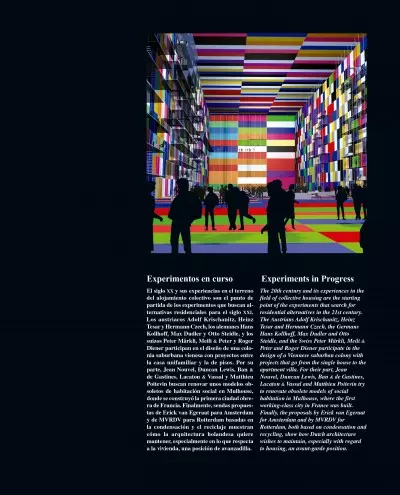VIVIENDA URBANA
Urban Housing
Luis Fernández-Galiano
El tapiz ciudadano
The City Tapestry
Experimentos en curso
Experiments in Progresss
Justo Isasi
Viena 9=12, una colonia modelo
Vienna 9=12, a Siedlung Prototype
Adela García-Herrera
Mulhouse, un proyecto-manifiesto
Mulhouse, a Manifesto-Project
Ginés Garrido
Amsterdam y Rotterdam, propuestas visionarias
Amsterdam and Rotterdam, Visionary Proposals
Escalas residenciales
Residential Scales
9 viviendas en bloque y cobertizo, Dornbirn (Austria)
9 Dwellings in a Block and a Barn, Dornbirn
Baumschlager & Eberle
10 viviendas en Witikon, Zúrich (Suiza)
10 Dwellings in Witikon, Zurich
Burkhalter & Sumi
17 viviendas sociales, Paterna de Rivera, Cádiz (España)
17 Social Dwellings, Paterna, Cádiz
Fernando Mejías & Manuel Narváez
21 viviendas en una vaquería, Santiago (España)
21 Dwellings in a Dairy, Santiago
Víctor López Cotelo
26 viviendas para jóvenes, Leipzig (Alemania)
26 Dwellings for Young People, Leipzig
Hentrich-Petschnigg & Partner
66 viviendas, talleres y oficinas, Viena (Austria)
66 Dwellings, Workshops and Offices, Vienna
BUSarchitektur
88 viviendas en bloques y tanques, Amsterdam (Holanda)
88 Dwellings in Blocks, Amsterdam
De Architectengroep
101 viviendas de realojo, Madrid (España)
101 Rehouse Dwellings, Madrid
Paredes & Pedrosa
113 viviendas sociales en Mendillorri, Pamplona (España)
113 Social Dwellings, Pamplona
Mangado & Alzugaray
119 viviendas (Hageneiland), La Haya (Holanda)
119 Dwellings (Hageneiland), The Hague
MVRDV
132 viviendas en ladera, St. Gallen (Suiza)
132 Dwellings on a Slope, St. Gallen
Baumschlager & Eberle, SENN Architektur
136 apartamentos (Main Plaza), Frankfurt (Alemania)
136 Apartments (Main Plaza), Frankfurt
Kollhoff & Timmermann
137 apartamentos en Chassé Park, Breda (Holanda)
137 Apartments in Chassé Park, Breda
Xaveer De Geyter
157 viviendas con oficinas (Silodam), Amsterdam (Holanda)
157 Dwellings (Silodam), Amsterdam
MVRDV
171 apartamentos en Pijnacker, Delft (Holanda)
171 Apartments in Pijnacker, Delft
Kees Christiaanse
172 apartamentos en Java Eiland, Amsterdam (Holanda)
172 Dwellings in Java Island, Amsterdam
Diener & Diener
195 viviendas en el distrito IV, París (Francia)
195 Dwellings in the IV District, Paris
Yves Lion
250 apartamentos (The Beam) en Donau, Viena (Austria)
250 Apartments (The Beam), Vienna
Delugan & Meissl
290 apartamentos en Zalmhaven, Rotterdam (Holanda)
290 Apartments in Zalmhaven, Rotterdam
Wiel Arets
440 apartamentos (torre Mischek) en Donau, Viena (Austria)
440 Apartments (Mischek Tower) ,Vienna
Delugan & Meissl
Luis Fernández-Galiano
The City Tapestry
The architecture of the house is the architecture of the city. From Filarete, the treatise writers were fond of explaining the house as a miniature city and the city as a large house. Although stacking dwellings does not make a city, the greater part of the urban fabric is formed by housing units, and the city reproduces at a large scale the functions of the residential microcosmos. If the city is just the materialization of relationships among citizens, if settlements can only be understood through their settlers, and if habitations are interwoven with the warp of their inhabitants, it is easy to see that, in the end, residential form determines urban form. From small groups of houses to large residential developments, the domestic types and their modes of assembly define the structure of the city and shape its characteristic environment, so that any housing project harbors an urban one, showing the tapestry that links the individual threads of independent lives with the thick web of collective existence.
This stubborn mesh of tangled trajectories traces a voluntary geography and an artificial landscape which we call city: a deliberate construction that supplies the scenarios of domesticity, and that comes at the same time from the multiplication of residential routine. Experimental because it expresses the artifice of the manufactured, and resistant because restricted by the tenacity of traditions within the mutating context of a city that “changes faster than the human heart”, the architecture of housing is torn between the innovation proposed by the designer and the continuity claimed by the developer, parallel protagonists of a process which frequently excludes the inhabitant: user for one of his spaces, consumer for another of his surfaces, but rarely respected as an autonomous person who tries to find in the dwelling a domestic utopia and a civil residence. The occupant is offended by those who submit him to fanciful experiences against his will; and he is not less insulted by those who flatter his taste, offering trivial fantasies of comfortable luxury.
Present in every field of professional practice, the so-called ‘signature architecture’ has also seized the realm of housing, perhaps the field most reluctant to singular expression given the evident plural nature of its sociological condition. The enforcement of authorship over the docile matter of collective residence exudes an imperative aroma – half-way between the demiurgic totalitarianism of the aesthetic adventure and the submission to the strict rules of the media spectacle – that invites skepticism. But the onerous servitude to the degraded mechanisms of the real estate market, relentless generator of residential and urban mediocrity, provokes an even greater suspicion, and a helpless outrage before the built products of that colossal machinery. Between the Escila of affirmative narcissism and the Caribdis of predictable commerciality, perhaps only the urban foundation of housing architecture serves at once as an intellectual compass for the domestic project and as litmus paper that discerns quality within the confused magma of residential constructions.








